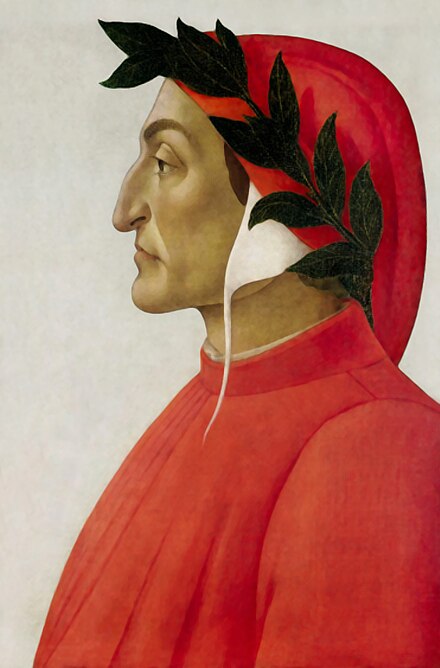
Portrait de Dante.
(Image by Wikipedia (commons.wikimedia.org), Author: Author Not Given) Details Source DMCA
Duluth, Minnesota (OpEdNews) February 16, 2023: Recently I read the American Jesuit Paul A. Soukup's 2022 exploratory book A Media Ecology of Theology: Communicating Faith throughout the Christian Tradition (Baylor University Press).
I discuss it in my somewhat lengthy OEN article "Paul A. Soukup, S.J., on a Media Ecology of Christian Theology" (dated December 24, 2022):
Over the years, Paul A. Soukup, S.J., in communication studies at Santa Clara University, the Jesuit university in northern California, and I worked together as co-editors of eight books (1991, 1992a, 1992b, 1993, 1995, 1999, 2002, and 2012) - seven of which are related to the work of the American Jesuit Renaissance specialist and pioneering media ecology theorist Walter J. Ong (1912-2003; Ph.D. in English, Harvard University, 1955), whose work Soukup draws on in his 2022 exploratory book.
In it (p. 41), Soukup briefly discusses Sheila J. Nayar's 2014 exploratory book Dante's Sacred Poem: Flesh and the Centrality of the Eucharist to Dante's "Divine Comedy" (Bloomsbury Academic), which came out in a paperback edition in 2016.
In it, Nayar operationally defines and explains what she means by the term "Sacred Poem" in the title, in Chapter 4: "Betwixt and Between: Dante's Purgatory." She says the following: "For many readers - perhaps most, these days - Dante's Inferno, with its imbricated horrors and colorful grotesquerie, is far more alluring than either Purgatory or Paradis. True, sin, revenge, and passion may evoke 'more life and dramatic movement than penitence and religious ecstasy' (Federn 284), but to miss - or intentionally elide - the other two canticles; to disregard their associatively vertical and horizontal powers; indeed, to read only 'Act I' and relinquish that act's very raison d'etre (its climax, its resolution, its ultimate goal) is arguably to deny the Comedy its sacredness. And Dante's Purgatory is not only symbolically, but also quite literally, the pathway to that sacredness - or, in another manner of speaking, it operates betwixt and between the 'backward' or 'wrong' realm of exclusively flesh-oriented and the 'right' or forward-looking realm of the inclusively divine" (p. 95; her italics; also see pp. 10, 159, 205, and 210-211).
Throughout her book, she dwells on how all three parts of Dante's poem are infused with Christological and Trinitarian theology - including certain parodies.
In Nayar's 2014 exploratory book, she also skillfully explores, as the book's subtitle suggests, the history of the Roman Catholic practice and of the theological theory of the Eucharist as central to Dante's Divine Comedy - that is, as central to all three of its parts: (1) the Inferno, (2) Purgatory, and (3) Paradise.
But Nayar does not explicitly explore Ong's work, as Soukup does in his 2022 exploratory book.
Now, arguably Ong's most relevant discussion of the Roman Catholic practice of the Eucharistic liturgy is his 1974 article "Mass in Ewondo" in the Jesuit-sponsored magazine America, volume 131, number 8 (September 28, 1974): pp. 148-151. It is reprinted in volume four of Ong's Faith and Contexts, edited by Thomas J. Farrell and Paul A. Soukup (Scholars Press, 1999, pp. 103-110).
Because Nayar discusses the hymns of St. Thomas Aquinas, Ong's most relevant about Aquinas is his "Wit and Mystery: A Revaluation in Mediaeval Hymnody" in the prestigious journal Speculum, volume 22, number 8 (July 1947): pp. 310-141. Ong reprinted it as "Wit and Mystery: A Revaluation in Medieval Latin Hymnody" in his 1962 essay collection The Barbarian Within: And Other Fugitive Essays and Studies (Macmillan, pp. 88-130). It is also reprinted in volume four of Ong's Faith and Contexts, edited by Thomas J. Farrell and Paul A. Soukup (Scholars Press, 1999, pp. 1-44).
Now, the Dutch Jesuit theologian Frans Jozef van Beeck explores the theory of the Roman Catholic Eucharistic liturgy and Christological theology in his lengthy ecumenical book Christ Proclaimed: Christology as Rhetoric (Paulist Press). But I should also call your attention to van Beeck's succinct 1991 article "Divine Revelation: Intervention or Self-Communication?" in the Jesuit-sponsored journal Theological Studies, volume 52 (1991): pp. 199-226.
I would be remiss if I did not mention here that the doctrinally conservative Pope Francis, the first Jesuit pope, has discussed both the practice and the theory of the Eucharistic liturgy in his 2022 apostolic exhortation Desiderio Desideravi (I Longed for the Desire): On the Liturgical Formation of the People of God - which is available online in English and other languages at the Vatican's website.
I have discussed it in my recent OEN article "Pope Francis on Catholic Liturgical Formation" (dated July 4, 2022):
(Note: You can view every article as one long page if you sign up as an Advocate Member, or higher).




